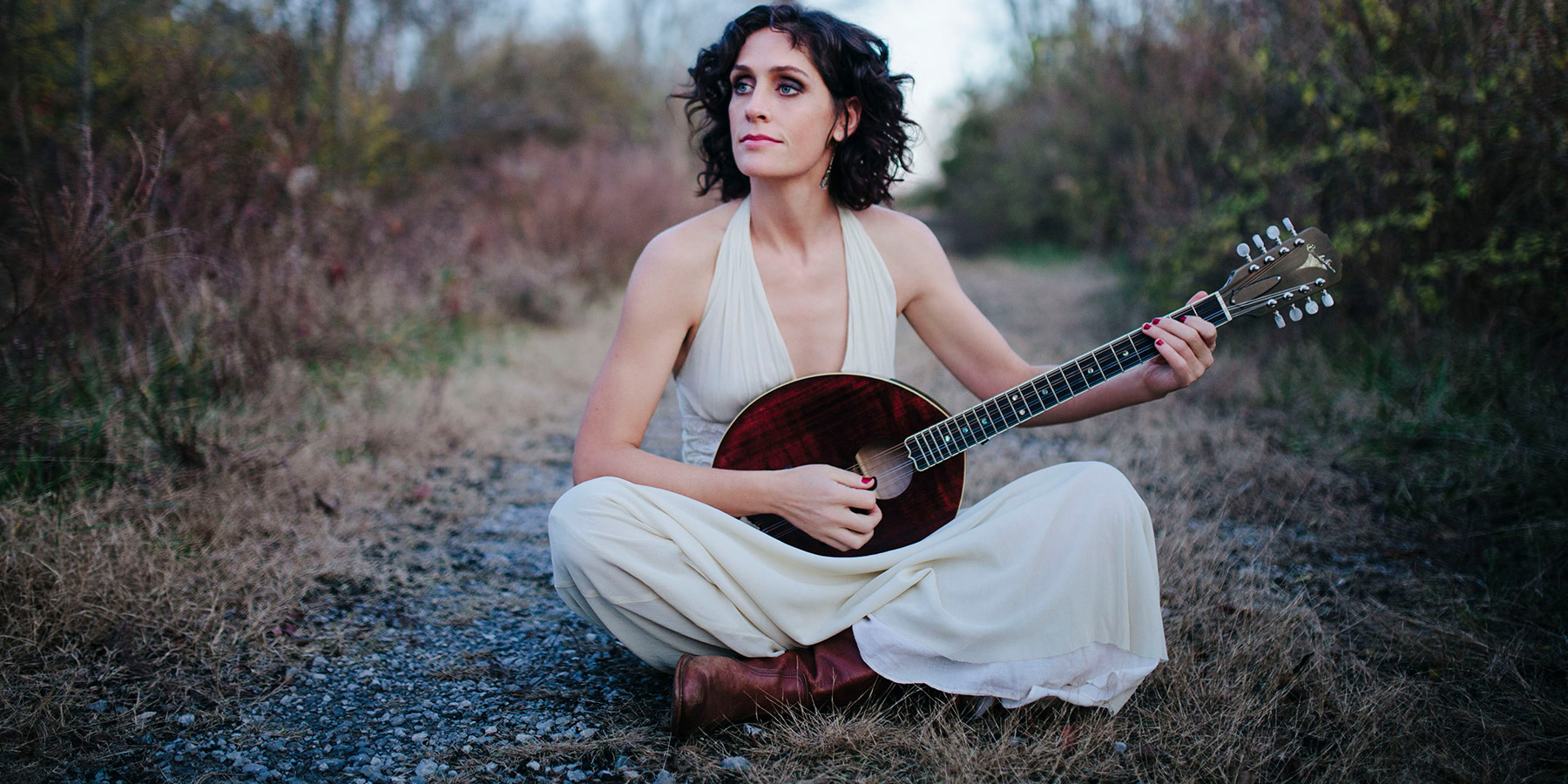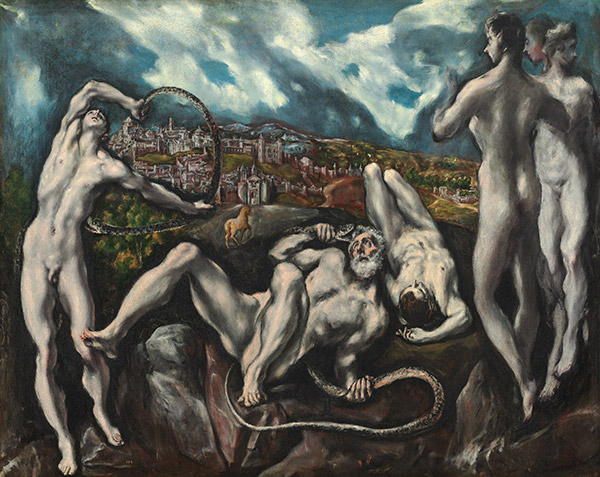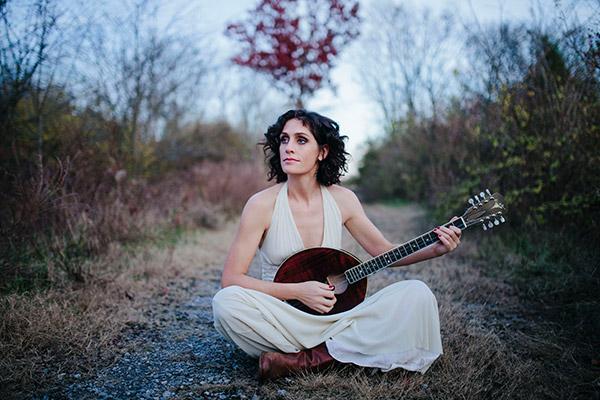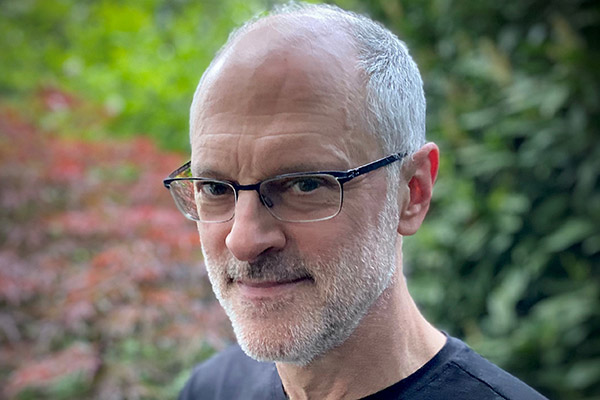Download Transcript (PDF 151KB)
[MUSIC PLAYING]
CELESTE HEADLEE: Welcome back to Sound Thoughts on Art, an audio series from the National Gallery of Art. I’m Celeste Headlee. When we engage with art, it kick starts our five senses. We hear music or feel the beat of a drum in our chest.
We see the vivid colors of a photo, we take in the three dimensions of a sculpture, we savor the taste of fine food. Sometimes, you can smell the carved wood or the smeared oil paint. But when there’s crossover, when a piece of art activates multiple senses and they begin to interact and intertwine, that’s when things really get interesting.
When we listen to melody, what images flash through our minds?
When we study the brush work in a painting, what do we hear? This podcast lives in that crossover, in the space at the center of our five senses’ Venn diagram. In each episode, you’ll learn about a work at the National Gallery, and you’ll hear a musician respond to that work through sound, creating a dialogue between the visual art and music.
Sound Thoughts on Art delves into our personal relationship with art and the unique response we have to beautifully made things.
[MUSIC PLAYING]
In this episode, we once again tackle a story dating back to ancient mythology, but its themes as ever prove applicable to the modern era. What it means to tell the truth, to whistle blow, to face indifference while in an emergency, and to witness collateral damage that might have been avoided. Laocoön was, as far as we can tell not, a real person. But in Greek mythology, he’s a tragic figure. A Trojan priest who warns his compatriots in the city of Troy not to accept a large wooden horse from the Greeks with whom they were at war.
Source texts vary on which god he might have angered by speaking up—maybe Athena, maybe Poseidon—and why they were so mad. It might have been the gods were angry at Laocoön for something unrelated. It may have been that the divine game was rigged against Troy. But for whatever reason, the gods sent serpents after not only Laocoön but his sons as well.
So what lesson are we supposed to take away from this brutal act of supposedly cosmic justice? It’s surely a different lesson now than it would have been in the early 1600s when a painter now known as El Greco took a crack at depicting the death of Laocoön. It’s a huge painting, and the dark chaotic scene would have been especially arresting for a viewer used to post-Renaissance cleanliness and order.
Jazz violinist, Jenny Scheinman, grew up appreciating this painting and the way it explores beauty in the same strokes of telling a deeply ugly story. She finds that contrast lends itself both to feeling and to music. Throughout this episode, you’ll hear not only “Sand Dipper,” the track that Jenny chose for us to discuss, but also “The Audit” and “July Tenth in Three Four.” All three are tracks off her 2012 album Mischief and Mayhem.
[MUSIC PLAYING]
So as I understand it, and please correct me if I’m getting this wrong, when the National Gallery contacted you about the possibility of being here, you were just on your way to DC, to visit DC, and so you extended your trip for a day and went and spent a day at the Gallery. Is that all right?
JENNY SCHEINMAN: That’s correct.
CELESTE HEADLEE: Yeah, you’re wandering through the galleries. Tell me about that day.
JENNY SCHEINMAN: That was such a wonderful day. This is mid pandemic. This is after... when was that? So I was in DC, I believe, to do—we were headlining the DC Jazz Festival, and that was a celebration of jazz violin. I was with Regina Carter and the String Queens, and we were playing out on the docks, and we were celebrating our heroes of jazz violin.
Very ecstatic concert.
I extended my trip by a day—and this is after not playing for—I don’t know, I guess it had been over a year. I haven’t not played—I hadn’t not played for over a year since I started playing, since the first four years of my life. It was a total shock to the system. (What I mean is performing, because I did play during the pandemic.)
But I was so grateful to be there and be out of my hometown, to be in DC. And so I was filled with that, just the community of DC and the everything that live performance fills me with, and so that day I extended my trip to be able to spend the whole day at the National Gallery. And I went over there by myself with an agenda, which was to walk into the Gallery and try to listen to what music came into my mind as I looked at the paintings and the art that was there.
CELESTE HEADLEE: So tell me about when you first saw the El Greco. What did you feel?
JENNY SCHEINMAN: I felt some sort of—it’s a huge environment that’s created in that piece. It’s hard to put it into words, and that’s why the music and art does it better. It’s this sort of unknowable, awesome confusion and unknowable world that’s created. Laocoön is looking up into life. You know, it’s his last glimpse of life before this serpent bites him in the neck. And he’s asking, what is this?
I don’t think he looks terrified, he looks like he’s wondering. It’s like the human mind there looking up and saying, this is it. And it’s still unknowable. And his sons are right next to him. There’s these two gods on the right side of the painting looking down at him, not answering.
It’s like, what we’re doing in art is addressing and reflecting this unknowable but very compelling world. And it’s a big feeling I got when I looked at that painting. And because I was thinking about music, it’s a subject that I often go to when I’m writing, which is reflect and create the unknowable and the experience that we’re all in in life, which is that we can’t really explain it, but we keep going through it, and
there are things that don’t make any sense at all to us.
But it’s huge and magnificent and very beautiful. It’s a very beautiful painting. I was struck by the horse in the middle of the painting, and only later—I grew up with the Greek gods a bit, and I’m also Jewish, though we weren’t observant. But I’m a bit immersed in the idea of the god world as very human, meaning it doesn’t make sense, hard to explain, impulsive, feels like betrayal a lot of the time, emotional.
The Greek gods can be like that.
And what I saw in the horse, which is trotting away in the distance, but it’s central to the painting, it’s right in the middle of the painting. It’s this little regular little horse going back toward Toledo, and it seemed like yet another version of betrayal, of not answering the question. And it is, actually—I think he was probably putting it in there because it’s the Trojan horse, which is central to the story of Laocoön.
To me, it looked like a regular part of life, horses being a important part of normal life probably at that time. And it’s just trotting away. It’s the companion trotting away, it’s another betrayal.
CELESTE HEADLEE: For more on El Greco, we turn to Jonathan Bober. He’s the curator and department head of old master prints for the National Gallery of Art.
JONATHAN BOBER: Well, there are figures in all sorts of tortuous postures. The principle one is an older man who’s reclining back on the ground but in a rather awkward posture. To either side are younger men, contorted—contorted and organized in a rather elegant pattern around his fall. And then off to the right are three: two figures clearly visible, entirely visible, behind them a third head. And all the figures are naked.
They are bathed in a very bright and kind of pale, high-key light.
The background. In the background, there is a city extending across the horizon on a hillside, beyond it a darkened sky with very bright cloud, as if illuminated by moonlight. And that bright light is very much the same kind of light that bathes those figures in the foreground. So it’s a very intense, a very complex weave of figures that almost entirely fills the fore plane, the front of the composition, with this rich and varied and deep-toned background. And the whole surface seems, as I say, vibrant with this light.
CELESTE HEADLEE: I think most people who see pictures of this in books may not appreciate the size of this.
JONATHAN BOBER: Well, as frequently—whether you’re sitting in an art history classroom looking at used to be slides, now projections, images of any kind in books scale as well as, of course, the material characteristics is, in a way, the most elusive. And the better the reproduction in a book, the more the assumption tends to be, that’s what it looks like. We experience the reproduction rather than the work itself.
It is a large canvas.
It’s about six feet high and almost seven feet wide. So very impressive. The figures are not life size, but they’re approaching the kind of scale that one feels a more visceral identification with them.
[MUSIC PLAYING]
CELESTE HEADLEE: I mean, nature is often indifferent to our suffering, right?
JENNY SCHEINMAN: Mm-hmm. Yeah.
CELESTE HEADLEE: Nature just goes on.
JENNY SCHEINMAN: Yep, and the sky is indifferent and awesome and powerful and doesn’t give any answer to what’s happening to Laocoön and his sons there on the ground as they’re being attacked by serpents that were sent by the gods.
CELESTE HEADLEE: One of the things that both visual and music have in common is that, very often, they are expressing the unexpressible. In other words, oftentimes when I look at El Greco, I try to imagine what it would be like, because Laocoön was right. Next to him is the body of his dead son and he’s looking up—it looks like he’s looking up at his son who is also about to die. And so what do you feel like is the mood? Do you think there’s grief here? Frustration? Injustice?
JENNY SCHEINMAN: I don’t see grief in it. I’m sure some people do. I mean, I read a little bit about it, and there’s a lot of talk of a world of suffering, all of this. And OK, they are being attacked by serpents and his sons are about to die right in front of him. And he’s right. It’s so unfair.
There’s no justice in this depiction of the world. And the gods are just watching. And the gods look young. I think it’s supposed to be Apollo and Artemis, and then there’s some sort of figure of something else in there. They’re uncompassionate.
I think there’s a question in his face. I think he’s saying, why? I mean, there’s still a tenderness in his face. He doesn’t have a face of agony. And I mean, honestly, I see him looking up at the sky. I don’t know if his gaze is directed exactly at his son.
That’s, I suppose, a matter of interpretation. He’s leaning back on one of the sons that’s closer to death, probably.
But it’s so unfair. It’s so unfair. He saw the destruction of Troy.
He knew that the Trojan horse was going to come in. It was treacherous, it was a ruse, and he was able to say that, but he was punished for it. It’s a kind of disloyalty or betrayal. That hurts a lot, that hurts—that juxtaposition.
[MUSIC PLAYING]
CELESTE HEADLEE: Do you think if you were the sound designer for this painting, what sounds would you assign to it?
JONATHAN BOBER: A very interesting question, because of course, our pretext here is relation of image and sound, image and art and music. That I am—as I’ve confessed openly and why the pairing with Jenny Scheinman is so welcome to me—I am a jazz fan, aficionado. What I see in it is the overwhelming characteristic of it is a vagueness of specific information: leaps of space, irrational leaps of space, and movement,
compositional movement in the painting. But all that brings to my jazz-obsessed mind a work or music that is more rhythmically insistent, that is even polyrhythmic, where there’s no clear or simple tonal center.
I see, I feel, the recording I imagine that might accompany this. You talk about sound design.
The space is so deep, but the connection between that foreground patterning of the figures and that depth so unclear, and some of the transition so abrupt, I think of a recording that is particularly big in space, whether actually recorded in a huge studio or a concert hall. But one in any case that would have a lot of reverberation, a lot of reverb. And one would feel a lot of space in the sound design.
So movement and space, critical characteristics in what I hear looking at it synesthetically.
CELESTE HEADLEE: In what ways is this work very like El Greco style?
JONATHAN BOBER: Oh, well, precisely the filling of that front plane with figures, with the action. Their organization into complex and what looks to our eye, especially to a 16th-century standard, organized according to what seems an arbitrary pattern. The figures are extremely distended, almost deformed by their movement and their organization into this rhythm, and that electric light. All of those things are typical of Greco.
Something that is very—seems to our eye irrational and against the grain of so much of Renaissance representation in its rationality, in its clarity, in its clear and plausible construction. Greco seems something straight out of the imagination and highly expressive, expressively charged. Way beyond any specific facial expression or even gesture.
The work itself and how it behaves formally convey a feeling that still affects us. And that is all very typical of Greco and part of why he’s so admired and has been so admired for the past century or so, and why he’s struck well those coming out of expressionism in the early 20th century. He seemed, still seems a kind of precursor or allied with that approach or that priority.
[MUSIC PLAYING]
CELESTE HEADLEE: So tell me about the connection between your response to this painting and the music that you chose.
JENNY SCHEINMAN: I immediately when I saw this got a song in my head that I’ve recorded. And it was on an album that I released with my band Mischief and Mayhem. Even the name of the band resonates with this painting, which I’m staring at on my computer as we’re talking.
But I believe it’s the second track on the album, it’s called “Sand Dipper.” And it creates a sort of chaotic, abstract, overwhelming world, where there are little bits of sense in a kind of senseless environment.
And what I direct—the chart of this song is basically a melody.
[VOCALIZING]
And I play the melody, which is—a sand dipper is actually a bird. It’s like a bird flitting through something in a pre-hurricane storm of wind and objects flying through, and the band gets to do all that. The band gets to create an environment that can or cannot relate to me. Sometimes they do, sometimes they land on one of the notes of my melody and they nail it down, but then they flit off again.
That, I think, sounds like what the sky looks like in this painting. And it feels like the unanswerable question that Laocoön is asking as he’s looking up into the world right before he dies.
CELESTE HEADLEE: Here’s “Sand Dipper” played in full.
[MUSIC - JENNY SCHEINMAN, “SAND DIPPER”]
Do you think of the piece as narrative?
JENNY SCHEINMAN: No, it’s a situation and it’s an environment. I would say it does develop. It starts small. It starts with a melody and a little bit of an environment, and then things get much more chaotic. And they expand from that into a larger space and a more dangerous environment, a more unpredictable environment.
After playing the melody a couple of times, I drop out. And we’re just living in the world of Nels Cline playing sounds on guitar and textures, and Jim Black dropping little bombs here and there, and Todd Sickafoose on bass. So Jim Black’s playing drums, Todd Sickafoose is sometimes joining in the mischief that Jim Black is doing, sometimes throwing in unpredictable lines. And it takes off from there.
So I guess there is a narrative. There’s not a narrative in the way that there is a narrative in songs with melodies and with clear developments, but there’s no reining it in in the song.
[MUSIC PLAYING]
JONATHAN BOBER: I look at works of art, as I look at—we look at works of art, as we listen to works of music at very different times, very different moods, very different ways. I generally like them separate. Or it may be music as background as I read and look, or I may imagine sounds as I look. But no, it’s not something I do regularly. Not something I do regularly.
I do enjoy consciously thinking about what music—how is the style of a given painting reflected, or is it reflected, in the music of the time? And then crossing, then going diachronic. And just as I’m doing with the Greco, and why I was excited to talk about it or talk with you about it is, it is something where I see these more telling analogies or relationships to music that I love.
[MUSIC PLAYING]
CELESTE HEADLEE: So what advice would you give to someone if someone came to you and said, I really would love to appreciate music more. What advice do you give to someone that would help them open themselves up to music?
JENNY SCHEINMAN: It’s exposure. It’s a language. Go out and see music. Take an hour at night and put on a recording and lay down, turn off your phone, and listen to it. Go out to see music with your friends, with your husband, with your kids. And if it’s unpleasant, go again.
It is the experience with music that you have to slow down and listen to it. And the beautiful thing about the language of music is that we all speak it and we all can understand it. It’s not like French or some other language that we don’t know. You just have to let it speak to you.
CELESTE HEADLEE: Is that different or similar to the advice you’d give to someone who wanted to appreciate visual art more?
JENNY SCHEINMAN: I think it’s the same, I think you just go. And you feel your feelings and you keep going and trust that this is an important part of life. One of the things I experienced that day at the National Gallery was that I was seeing a lot of paintings I’ve seen before but another time.
And I’ve seen some of these paintings since I was little. We used to go to museums when I was a kid. And I’d be dragged through the museum, and maybe there’d be a couple of things I’d like. And maybe I’d enjoy it for the first 30 minutes, but my mom would drag us through for hours. And all I’d remember leaving was that my feet hurt, and I was hungry and, why weren’t there more benches, and my mother was so annoying.
But then I went again and she did it again and again and again and again. And by the time I was actually able to do it on my own, I’d do it! And sometimes it was that I thought I would get something out of it, not just that I wanted to go. And that day at the National Gallery, I was just so grateful that I had these paintings in my life that I could revisit. And it was like visiting relatives.
Of course I saw a lot of paintings that I’d never seen before, but some of these familiar ones were so comforting, I guess. And I returned to a place, sort of like a family photo book or something. So I guess it’s just: go. Go and see it, and feel what you feel when you’re there.
[MUSIC PLAYING]
CELESTE HEADLEE: Thanks so much to Jenny Scheinman for joining us. Jenny performed her original work, Kannapolis: A Moving Portrait, which she mentioned in her interview, at the National Gallery of Art on May 22, 2016. She returned with a different group to perform her album Parlor Game at the National Gallery on November 3, 2018. Sound Thoughts on Art is a production of the National Gallery of Art music department.
The show was created by Danielle Hahn, the National Gallery of Art’s head of music programs, and it was mixed and produced by Maura Currie. To support the show, share Sound Thoughts on Art and subscribe on Apple Podcasts, Google Play, Spotify, or wherever you listen. I’m Celeste Headlee. Until we meet again, be well.
[MUSIC PLAYING]



